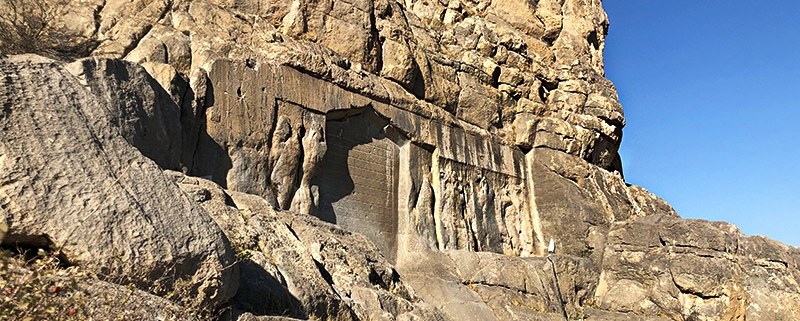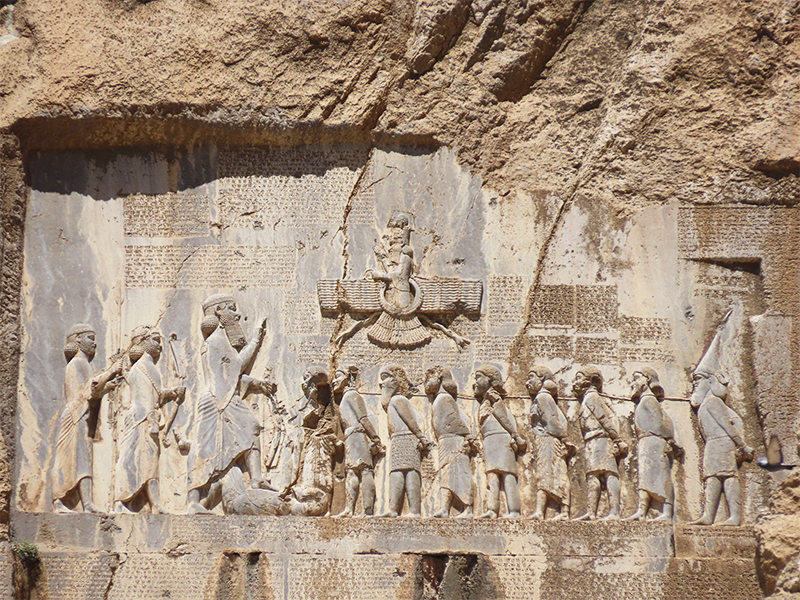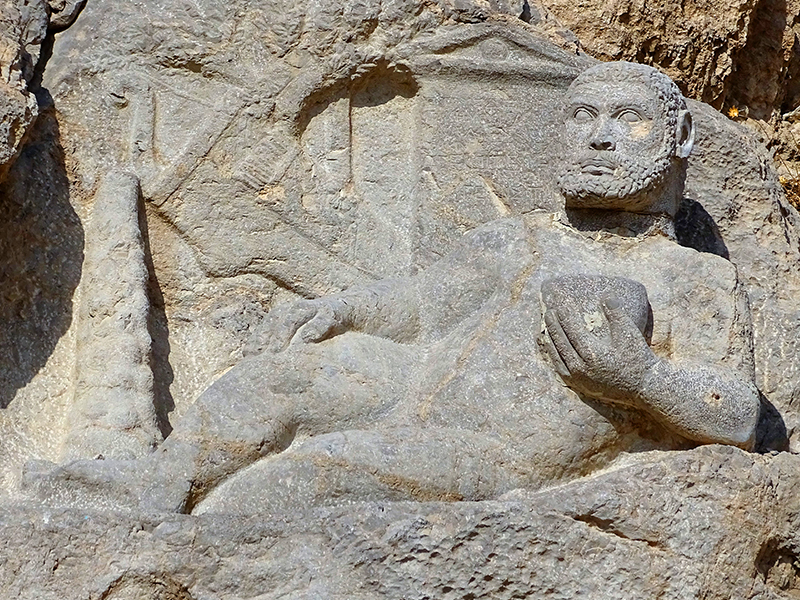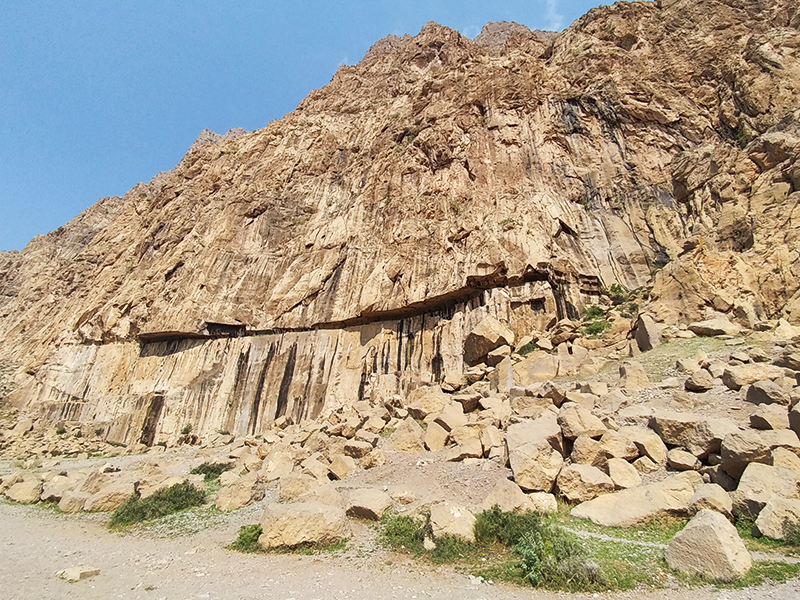Bisotun (Behistun), Kermanshah: Inscription, History
The Bisotun complex, situated in the west of Iran in the historical city of Kermanshah, is a world-famous archeological site and is one of the few places in Iran with its name marked on the UNESCO World Heritage List. The Bisotun inscriptions, caves, mirages, and several other places in Biston all have great cultural, historical, and natural values. Due to the presence of historical works in Bisotun that date back to approximately four thousand years ago, this ancient location is regarded as a historical treasure to Iran. In this article, we are going to delve into one of Iran’s national gems.
About Bisotun Archaeological Site
Bisotun Complex is one of the most cherished attractions in the city of Kermanshah. In 2013, Iran registered Bisotun as a national monument, and in 2015, the inscription and petroglyph of Darius the Great (Persian ruler of the Achaemenid Empire who reigned from 522 BCE until his death in 486 BCE) were marked on the list of UNESCO’s world monuments.
The Biston complex, with an area of 1,650 hectares, has considerable diversity and value in terms of history, nature, and environment. But what has made Bisotun renowned worldwide is the inscription of Darius the Great, belonging to 520 BC.
The Bisotun Collection
The historical works in Bisotun that date back to about four thousand years ago are great in number, but 28 of the works have been registered as national relics of Iran. The Bisotun archaeological site monument contains a large number of historical monuments such as the Hercules statue, Biston Bridge, Shah Abbasi Caravanserai, Mehrdad II engravings, the popular Farhad Tarash, etc. One of the works of this collection is the inscription and carved relief of Darius. In addition, the existence of numerous caves in Biston Mountain implies the existence of ancient civilizations in this area during the Paleolithic era (Stone Age).
Other popular works that you can sightsee in this 28-works collection include Shekarchian (Hunters) Cave, Mar Doder Cave, Bisotun Mirage, Mar Tarik Cave, Medes Monastery, Sange Balash, Mehrdad Ashkani (Parthian Empire) Engraving, Goudarz Engraving (An Iranian mythical Hero), Ilkhani Caravanserai, etc. These irreplaceable and valuable works are considered important documents of Iranian history.
The value and significance of Biston can be traced back to the Paleolithic era; especially, the caves and rock shelters of Bisotun confirm that this area was one of the most important settlements in the Zagros Mountain Ranges of Iran.
What Does “Bisotun” Mean?
Bisotun is derived from the word “Baghestan,” which means the land of the gods, and it is possible that its ancient name was “Bagastana”. Over time, Bisotun’s title was changed to “Bahistan,” and later “Bahistun”; Until after the country’s transformation to Islam, it was called “Beheston,” which means a better column or support. Today, it is called Bisotun; However, reading it as “bi-sotun” which in Persian means “without columns or pillars” is wrong, and the word “bi” meaning without, has no relation to the title of this location. Bisotun is one word that has changed over the years and symbolized the land of the gods.
Bisotun History
Bisotun is one of the most important historical monuments from the Achaemenid period, which describes the victory of Darius the Great against Bardiya or Smerdis (son of Cyrus the Great) who finally won the battle. Therefore, the reason for the construction of Biston can be seen as a demonstration of the power of Darius the Great and his army.
The Monuments and The Periods They Belong to
This historical and ancient area includes the works of various periods from pre-history to post-Islam. Shekarchian cave and Merkharrel cave from the prehistoric period, and the Madi shrine from the Medes period. The Biston inscription and bas-relief from the Achaemenid period, the figure of Hercules from the Seleucid period, the Balash stone, the Goudarz petroglyph, and Mehrdad Parshani carving belong to the Parthian period.
The Biston Palace, Farhad Tarash, the Sasanian building, and the Sassanid Bridge (Khosro) are from the Sassanid period, the Ilkhani Caravanserai from the Ilkhanid period, the Shah Abbasi Caravanserai, the inscription of Sheikh Ali Khan Zanganeh and the Bistun Bridge (Safavi Bridge) are from the Safavid period.
Bisotun History Facts
Bisotun complex is one of the most distinguished historical sites of the country, which had been an admiring location for the kings and rulers of ancient Persia for various reasons. Among those reasons, one of them is its favorable weather and good geographical location. Moreover, Bisotun was located near Mesopotamia (a historical region of West Asia), which means the Bisotun Plain was built near major transportation routes such as the Med-Babol Road and The Silk Road. This itself depicts the reason for the attention of the kings of different dynasties toward Bisotun.
Farhad Tarash
The carved rock of Farhad Tarash is one of the largest carved rocks in Iran, with a width of 200 meters and a length of 36 meters. On the rock of Farhad Tarash, you can see traces of boasting chisels. There are several motives for the formation of this rock, but one of the most probable of them is the inscriptions of a historical event by Khosrow Parviz, the Sassanid king. According to Persian literature, Farhad Tarash has undoubtedly an unforgettable story for all Iranians.
In fact, in the poems of Ganjavi (Persian poet), there is a love story between Shirin and Farhad, and people regard Farhad Tarash carving, the work of Farhad, who gave his life to carve his love, Shirin (the wife of Khosro Parviz) on a rock all by himself.
Bisotun Inscription
Bisotun inscription was written in cuneiform in three versions of the ancient Persian language, Elamite language, and Akkadian language, and as a result, it was one of the effective factors in deciphering ancient Persian language and cuneiform. All these texts have the same meaning and knowing one, you can easily translate another one and understand the meaning of the words.
On this monument, you will see the Bisotun inscription full text, as well as the image of Darius the Great carved (181 cm tall), and behind him are two of his generals who are shorter than Darius the Great. The face of the king is carefully carved and has perfect details. The ten rebels are also much shorter than the rest, and all of them are chained to each other, which illustrates the domination of King Darius over the rebels who have been defeated.
In this eccentric inscription, the king has raised his right hand as a sign of worshiping Faravahar. Thus, according to the details in this stone inscription, we can conclude that the purpose of its creation was not only to show power but also to promote the worship of Faravahar, the symbol of Ahura Mazda (the creator deity).
Bisotun Inscription Summary
King Darius says: There was no man, either Persian or Mede or of our own dynasty, who took the kingdom from Gaumâta, the Magian. The people feared him exceedingly, for he slew many who had known the real Smerdis. For this reason, did he slay them, ‘that they may not know that I am not Smerdis, the son of Cyrus.’ There was none who dared to act against Gaumâta, the Magian until I came. Then I prayed to Ahura Mazda; Ahura Mazda brought me help.
Final Words
If you want to discover more about the history of Iran, you have to travel to its different provinces. In each region of the country, you can see symbols of the greatness and authority of Iranians in different periods. One of the best locations is the Bisotun complex of Kermanshah, which has a long history and contains very valuable historical works. Being one of the monuments registered as a UNESCO World Heritage Site, the Bisotun cave is certainly a remarkable place for visitors who love archeological sites.
Are you planning to travel to Iran and looking for an Iran travel agency? Check out our Iran tours. Find more interesting Things to Do in Kermanshah.









Leave a Reply
Want to join the discussion?Feel free to contribute!